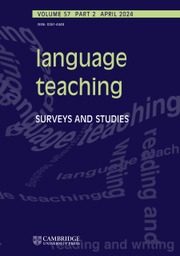Crossref Citations
This article has been cited by the following publications. This list is generated based on data provided by
Crossref.
Gallardo del Puerto, Francisco
and
Gómez Lacabex, Esther
2008.
La enseñanza de las vocales inglesas a los hablantes de español..
Pulso. Revista de educación,
p.
37.
Hwang, Eunha
2008.
Factors Affecting Korean Learners’ English Pronunciation and Comprehensibility.
English Teaching,
Vol. 63,
Issue. 4,
p.
3.
Zielinski, Beth W.
2008.
The listener: No longer the silent partner in reduced intelligibility.
System,
Vol. 36,
Issue. 1,
p.
69.
Henderson, Alice
2008.
Towards intelligibility: Designing short pronunciation courses for advanced field experts.
ASp,
Vol. 53-54,
Issue. ,
p.
89.
Gilner, Leah
and
Morales, Franc
2008.
Elicitation and application of a phonetic description of the General Service List.
System,
Vol. 36,
Issue. 4,
p.
517.
Saito, Kazuya
2011.
Examining the role of explicit phonetic instruction in native-like and comprehensible pronunciation development: an instructed SLA approach to L2 phonology.
Language Awareness,
Vol. 20,
Issue. 1,
p.
45.
Saito, Kazuya
and
van Poeteren, Kim
2012.
Pronunciation-specific adjustment strategies for intelligibility in L2 teacher talk: results and implications of a questionnaire study.
Language Awareness,
Vol. 21,
Issue. 4,
p.
369.
Saito, Kazuya
and
Lyster, Roy
2012.
Effects of Form‐Focused Instruction and Corrective Feedback on L2 Pronunciation Development of /ɹ/ by Japanese Learners of English.
Language Learning,
Vol. 62,
Issue. 2,
p.
595.
Young-Scholten, Martha
2013.
Universal Grammar and the Second Language Classroom.
Vol. 16,
Issue. ,
p.
207.
Fotovatnia, Zahra
and
Omidi, Mahboubeh
2013.
The Effect of Exposure to the Visual Medium on Learning Pronunciation and Word Stress of L2 Learners.
Theory and Practice in Language Studies,
Vol. 3,
Issue. 5,
Lee Myoung-Ja
2013.
Using Acoustic Analysis Contents (Praat) for Teaching Sound Pronunciation.
Studies in Linguistics,
Vol. null,
Issue. 27,
p.
177.
Sardegna, Veronica G.
Lee, JuHee
and
Kusey, Crystal
2014.
Development and validation of the learner attitudes and motivations for pronunciation (LAMP) inventory.
System,
Vol. 47,
Issue. ,
p.
162.
Alghazo, Sharif
2015.
The role of curriculum design and teaching materials in pronunciation learning.
Research in Language,
Vol. 13,
Issue. 3,
p.
316.
Lintunen, Pekka
Peltonen, Pauliina
and
Webb, Joshua
2015.
Investigating English Pronunciation.
p.
196.
Murphy, John M.
and
Baker, Amanda A.
2015.
The Handbook of English Pronunciation.
p.
36.
Mompean, Jose A.
2015.
Phonetic notation in foreign language teaching and learning: potential advantages and learners’ views.
Research in Language,
Vol. 13,
Issue. 3,
p.
292.
Rahimi, Meisam
2016.
Second language articulatory training and computer-generated feedback in L2 pronunciation improvement.
ITL - International Journal of Applied Linguistics,
Vol. 167,
Issue. 2,
p.
190.
Rahimi, Mehrak
and
Ruzrokh, Sahar
2016.
The impact of teaching Lingua Franca Core on English as a foreign language learners’ intelligibility and attitudes towards English pronunciation.
Asian Englishes,
Vol. 18,
Issue. 2,
p.
141.
Saito, Kazuya
and
Shintani, Natsuko
2016.
Do Native Speakers of North American and Singapore English Differentially Perceive Comprehensibility in Second Language Speech?.
TESOL Quarterly,
Vol. 50,
Issue. 2,
p.
421.
Lee, Andrew H.
and
Lyster, Roy
2016.
Effects of Different Types of Corrective Feedback on Receptive Skills in a Second Language: A Speech Perception Training Study.
Language Learning,
Vol. 66,
Issue. 4,
p.
809.

